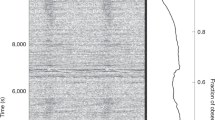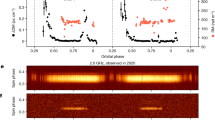Abstract
Neutron stars with rotation periods in the millisecond regime have been observed both as an isolated pulsar (PSR1937 + 214)1 and as a pulsar with a low-mass binary companion (PSR1953 + 29)2. We report here an upper bound to the X-ray luminosity of the latter of Lx < 4 × 1032 erg s−1, and consider the consequences of this and other observational data for theoretical models of this pulsar's formation and spindown. The two fast pulsars have features in common which suggest a similar genesis (very low magnetic field and surface temperature, low galactic latitude) and we propose that both are members of a new class of radio pulsars3. We argue that their immediate ancestors were neutron stars in galactic bulge X-ray sources, which accrete from close, low-mass (≲1M⊙) binary companions and spin-up in the process. In this scenario, an isolated fast pulsar results from a tight binary where mass outflow from a (still) main sequence secondary is controlled by angular momentum loss from the binary motion. A wider binary, where Roche-lobe overflow is sustained by nuclear evolution of the secondary into a red giant phase, ultimately leaves behind an old spun-up pulsar with a light remnant companion. In both cases, the neutron-star progenitors would have been white dwarfs which collapsed under excess accreted mass4–7. These neutron stars, then, are old (≫ 107 yr for binary pulsars, >109 yr for isolated ones) which accounts for their anomously low magnetic fields, and their consequent fast spins and low spindown rates.
This is a preview of subscription content, access via your institution
Access options
Subscribe to this journal
Receive 51 print issues and online access
$199.00 per year
only $3.90 per issue
Buy this article
- Purchase on Springer Link
- Instant access to full article PDF
Prices may be subject to local taxes which are calculated during checkout
Similar content being viewed by others
References
Backer, D. C., Kulkarni, S. R., Heiles, C., Davis, M. M. & Goss, W. M. Nature 300, 615–618 (1982).
Boriakoff, V., Buccheri, R. & Fauci, F. IAU Circ. No. 3806 (1983).
Alpar, M. A., Chenq, A. F., Ruderman, M. A. & Shaham, J., Nature 300, 728–730 (1982).
van den Heuvel, E. P. J. Ann. N.Y. Acad. Sci. 302, 14 (1977).
Miyaji, S., Nomoto, K., Yokoi, K. & Sugimoto, D. Publ. astr. Soc. Jap. 32, 303 (1980).
Sugimoto, D. & Nomoto, K., Space Sci. Rev. 25, 155 (1980).
Nomoto, K. in Proc. Workshop on Type I supernovae, Austin (1980).
Giacconi, R. et al. Astrophys. J. 230, 540–550 (1979).
Helfand, D.J., Chanan, G.A. & Novick, R. Nature 283, 337–343 (1980).
Ruderman, M. A. & Shaham, J. Comments Astrophys. (in the press).
Webbink, R. F., Rapport, S. & Savonije, G. J. Astrophys. J. (in the press).
Press, W. H., Wiita, P. J. & Smarr, L. L., Astrophys. J. Lett. 202, L135–L137 (1975).
Lecar, M., Wheeler, J. C. & McKee, C. F. Astrophys. J. 205, 556–562 (1976).
Reimers, D. Mem. Soc. R. Sci. Liege 6th ser 8, 369–374 (1983).
Cheng, A. & Helfand, D. J. Astrophys. J. (in the press).
Helfand, D. J. Supernova Remnants and Their X-ray Emission, IAU Symp. No. 101 (in the press).
Ruderman, M. A. & Shaham, J. Preprint (Columbia University, 1983).
Author information
Authors and Affiliations
Rights and permissions
About this article
Cite this article
Helfand, D., Ruderman, M. & Shaham, J. X-ray emission and spin-up evolution of the 6.1-ms pulsar. Nature 304, 423–425 (1983). https://doi.org/10.1038/304423a0
Received:
Accepted:
Issue Date:
DOI: https://doi.org/10.1038/304423a0
This article is cited by
-
Formation of Double Neutron Stars, Millisecond Pulsars and Double Black Holes
Journal of Astrophysics and Astronomy (2017)
-
Magnetic Fields of Neutron Stars
Journal of Astrophysics and Astronomy (2017)
-
The population of binary and millisecond pulsars
Journal of Astrophysics and Astronomy (1995)
-
Pulsars: their origin and evolution
The Astronomy and Astrophysics Review (1989)
-
Discovery of a binary millisecond pulsar in the globular cluster M4
Nature (1988)
Comments
By submitting a comment you agree to abide by our Terms and Community Guidelines. If you find something abusive or that does not comply with our terms or guidelines please flag it as inappropriate.



